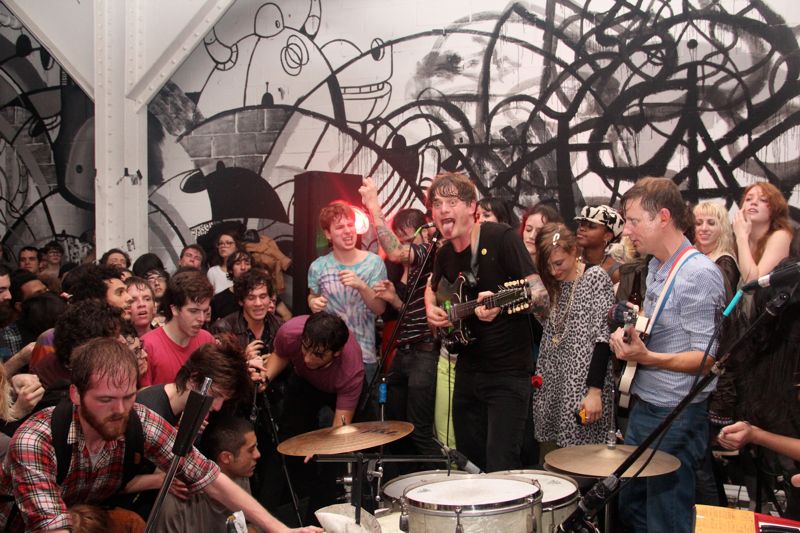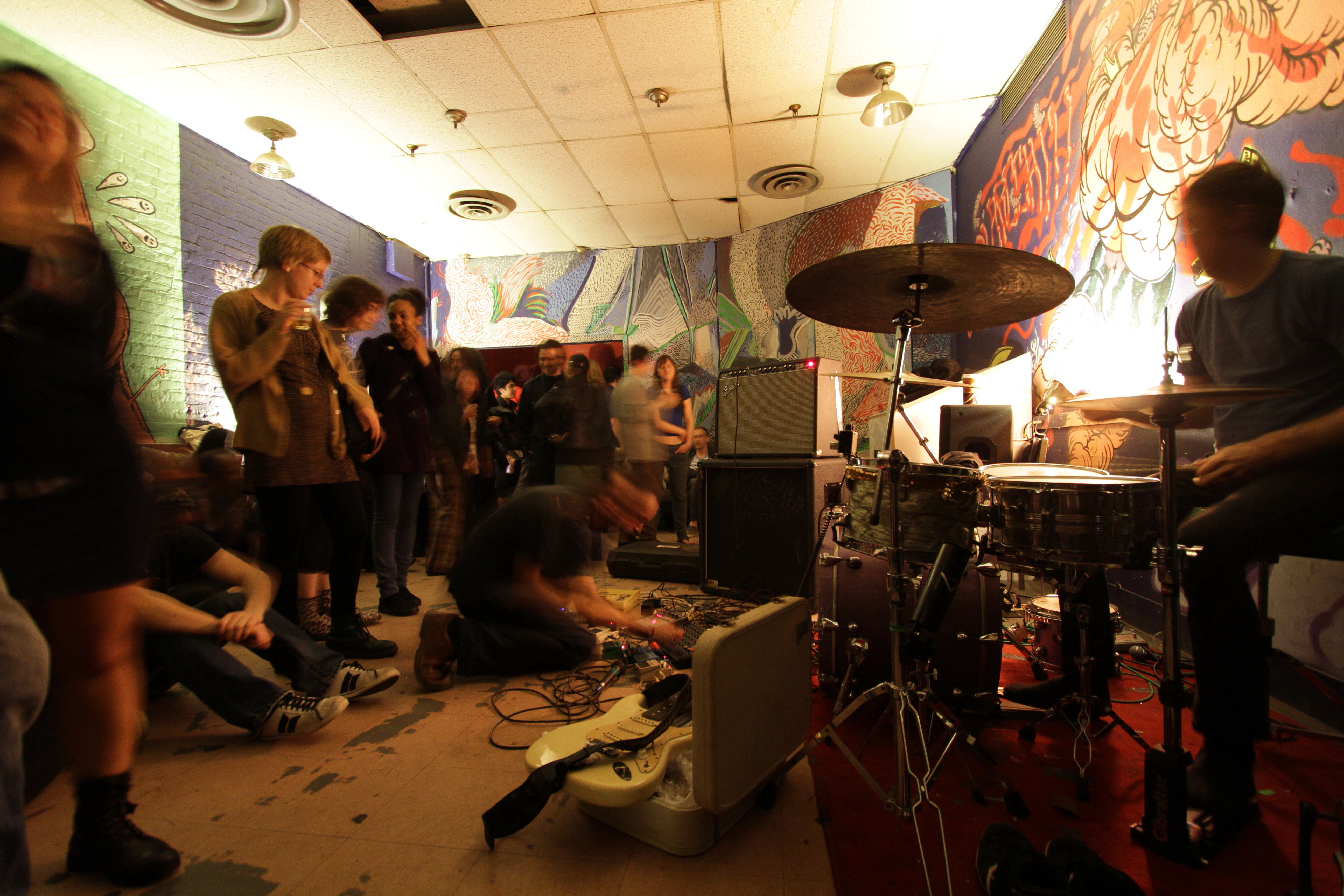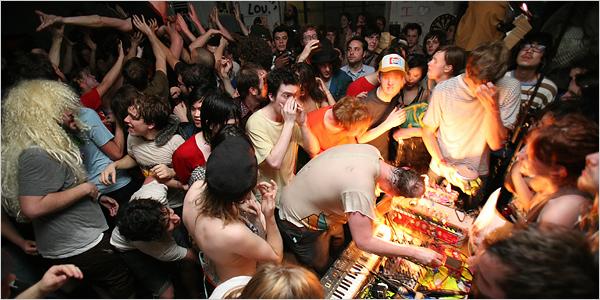285 kent ave
space type: music venue | neighborhood: williamsburg | active since: 2010–2014 | links: twitter
Update, January 2014:
No one expected 285 Kent to last forever, and news of its closing was just released. It’s not worth making any grand claims about the death of DIY or the condo-ification of Williamsburg; all those things have been said, and countered, and re-said, and re-countered. Whatever—the scene moves on, new venues will spring up, and the hyper-rich will galavant along the waterfront and probably not even know what went on there before they came.
285 Kent closing is kind of a big deal, though, even if only as a high-profile sign of the times. The space has been memorialized in some terrific oral histories over the last few weeks, from Animal New York to Village Voice to Fader, not to mention the one on Noisey made up of a pastiche of Yelp comments. They’re all worth a read if you want to get a little nostalgic.
***
Original post, November 2013:
One of the hubs of North Brooklyn’s DIY music scene, 285 Kent is an all-ages venue for cutting-edge music across genres. On the Williamsburg waterfront, across the street from the about-to-be-demolished Domino Sugar Factory, 285 Kent neighbors several other underground stalwarts like Glasslands, Death By Audio, Ran Tea House, and Cameo Gallery.
The space has seen several incarnations; in the mid-2000s it was Paris/London/West Nile, focusing on progressive electronic music, and before that it was Bohemian Grove (not the Bohemian Grove in Bushwick), hosting progressive raves. PLWN was started by the Shinkoyo Collective, an ever-expanding group of artists and musicians who were also behind the original Silent Barn and many more spaces across the country. Along with other Brooklyn DIY promoters, the space has been run at various times by Todd P., Babycastles, and John “Rambo.” These days 285 Kent’s booking and curation is handled by Ric Leichtung, who is also cofounder of Ad Hoc, a quarterly zine and network of taste-making music blogs.
This is the obvious point at which to mention the awful hyper-gentrification of Williamsburg, and the fact that no matter how beloved 285 Kent and other similar DIY institutions are, it’s hard not to be cynical about the likelihood that they will last much longer where they are. I guess the least pessimistic thing to say is this: go see shows at 285 Kent, as often as you can; get exposed to excellent, cutting-edge music and support the last gasp of underground Williamsburg before all that’s left is horribly shiny luxury glass condos and preposterously upscale bars for bankers.
But first check out my Q&A with Ric & Kait, who oversees daily operations.
brooklyn spaces: Is it a tremendous amount of work to run a space like this?
Ric: Yes, definitely. When I first started working here I was also writing for Pitchfork and Altered Zones, and it really snowballed. When you start something it’s difficult, and usually the more you work at it the easier things get. But 285 just keep getting higher and higher profile bands more and more often, and I couldn’t do it all myself. I needed a partner, and I was really lucky Kait came along.
Kait: He was starting his days at 9am writing, and then running a show until 4am. For months and months.
Ric: Yeah, but now it’s amazing. Kait’s the backbone.
brooklyn spaces: If you had to be a bit reductive, what would you say is the musical personality of 285 Kent?
Ric: We basically do whatever we think is culturally relevant right now. We do a lot of buzz-y, hype-y shows, but we also do a lot of hardcore shows and progressive dance and experimental music nights.
Kait: There’s such a crazy variety. I can show up on Tuesday and work a rap show, Wednesday a local indie band, Thursday a rave, Friday a hardcore show. And it’s always really cutting-edge, underground stuff.
Ric: The goal is to create a space where there’s a lot of exchanging of ideas and cross-pollination. Lately a lot of punk and hardcore kids have been coming to the dance parties, which you really don’t see anywhere else.
brooklyn spaces: Do they dance?
Kait: Yeah! They just totally love music.
Ric: But then we also recently had a string of a really great hardcore shows. We hosted this festival our friend Adam Weitz put together, New York’s Alright, and it was very comprehensive, everything that is next level in that community.
brooklyn spaces: Didn’t you guys do a big show here for CMJ?
Ric: Yeah we hosted the Pitchfork showcase, which was really special. But it was unofficial; we didn’t have any CMJ shows here this year because we’ve chosen not to participate in the festival.
brooklyn spaces: Is that something you want to talk about?
Kait: I think it’s something we should explain. My personal point of view—not affiliated with Ad Hoc or 285—is that buying a badge and not being guaranteed entry to a show? That kind of sucks. I think if you really want to see a band, you should pay the cover and support the artist. We don’t make a profit from the door. We cover our PA and staff, and the rest goes to the band.
Ric: In my opinion, the real issue with CMJ and other citywide festivals is that money only goes to the top-tier artists. Bands that should be getting $500 to $1,000 a show, they’ll be low-balled into playing for really cheap, in exchange for publicity or the opportunity to play with a really big band. The best things that were going on during CMJ this year were our Pitchfork showcase, the Arcade Fire warehouse show, and the Fader Fort, and none of that was official CMJ. It’s bullshit. They don’t pull their weight, that’s why we choose not to work with them.
brooklyn spaces: Okay, tell me about a particularly fun or crazy show you’ve had here.
Kait: One of my favorite nights was the Mutual Dreaming Future Times party. The promoter Aurora brought in this huge army-surplus parachute, and we hung it up inside, suspended by the pipes in the ceiling. It took hours to set up, but the place looked really, really cool. Then it turned out that there was a blizzard that night, but we still opened up because why not? And people came and were kind of stuck here, so we just partied all night, everybody in this giant parachute, in our own little bubble. It was amazing.
Ric: One of my favorites was Dreams 3.0. It was just a super forward-thinking lineup, with Pictureplane, Grimes, and Arca, who’s now producing for Kanye West. We’d done a show with this guy Arab Music a few months before, and he had such a good time that he just came back for no fucking reason to this already bonkers party, and he brought A$AP Rocky with him too. It was insane. The show went all night, Grimes didn’t go on until 3am. That’s probably the show we’ll be remembered for; it was just everything that was really really sick at that moment, in 2011, all at once. But we still do really cool stuff now, in 2013!
brooklyn spaces: In some ways you bear a real responsibility, as one of the people driving this scene; you have to not know just what music is important now, but what will be important tomorrow and next month. Is that a lot of pressure? Or is it just really exciting?
Ric: I think it’s really exciting.
Kait: It’s scary sometimes, too. Sometimes I wonder, “Am I totally off on this?” But then: nope. We just do what we think is cool.
Ric: There’s this guy DJ Rashad who we really love, we started booking him a couple of years ago and no one would ever really come to the shows. And then all of a sudden people start listening to his album, and suddenly he’s the #1 electronic album from Spin, he gets a top-10 on New York Times last year, all this sudden acknowledgment. That felt really good. Or one thing I really love about this space is that I feel like we’re bringing dance and electronic music to the DIY punk-rock demographic. I wasn’t really interested in that kind of music before, but then I had some kind of epiphany and I realized this stuff is amazing and progressive in so many ways. I would say it’s kind of a weird secret agenda of ours to make dance music cool again.
brooklyn spaces: I think when a booker is at the forefront of some genres, there is often an assumption that you’ll know what’s at the forefront of all the genres.
Ric: That’s what we hope.
Kait: Yeah, it’s pretty cool. On the weekends especially, we get people who have no idea what to expect, they just walk up and check out the show. We get people dressed up like they’re going clubbing wander into a noise show. And they’ll stay!
brooklyn spaces: I wonder how much longer that juxtaposition will be possible, with the way Williamsburg is going. I know it’s a bit played-out to talk about the death of this neighborhood, but being right here, with the Domino Sugar Factory about to get torn down across the street, how do you guys feel about it all?
Kait: I think it’s kind of cool, actually. I’ve had many conversations with Todd about this, because he did lay the groundwork for the DIY music scene in this area in the last decade. He’ll get really philosophical about it, very nihilistic. But I feel like all of this is bringing back that fuck-all attitude, which makes it really easy for us to just do what we want, you know? We have no idea what’s going to happen in two months, so let’s just make this place as cool and as fun as we can for as long as we can. It’s empowering. We’re laughing in the face of progress or whatever.
Ric: It’s true. It does sort of feel like there’s a death clock, but it’s okay.
Kait: Yeah, it’s like, fuck it. Fuck your death clock. Because it’s not like we’re just going to stop, even if we do lose this space. I can’t imagine Ric not booking shows, and I can’t imagine not working in a space like this. I’m here all the time and it’s just where I want to be. Sometimes it smells bad, sometimes shit breaks, but the staff is amazing, everybody works really hard to keep it all together.
Ric: It’s like a little family—not to sound too trite. And we’re planning other things all the time. We’re putting on a show in a church in LA with Julianna Barwick and Mark McGuire from Emeralds. And there’s going to be some pretty crazy stuff during New Year’s Eve—stay tuned for that.
Kait: Oh, I don’t even know about that. Is it DJ Rashad?
Ric: Maybe. It’ll be good.
***
Like this? Read about more DIY music spaces: Fort Useless, Death By Audio, Shea Stadium, Silent Barn, Monster Island, Bushwick Music Studio, Newsonic


































































